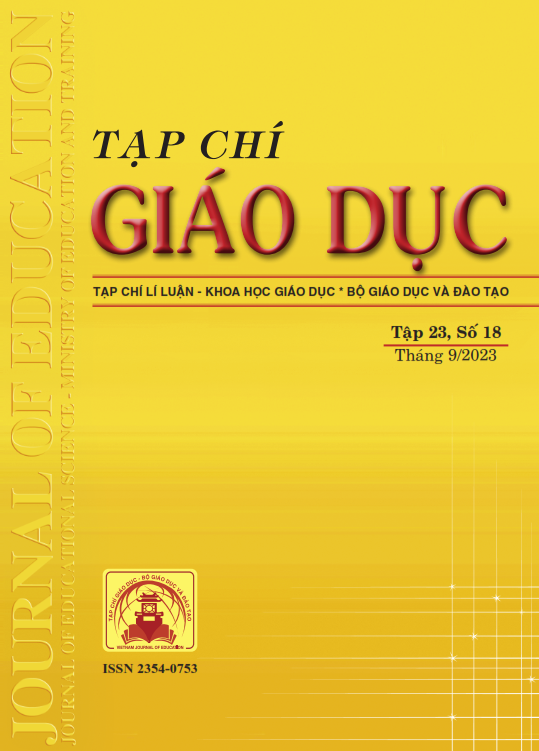Dạy học dựa trên bối cảnh theo mô hình 5E: trường hợp chủ đề “Dao động” (Vật lí 11)
Tóm tắt
In the context of implementing the 2018 General Education Program, teachers need to adapt their teaching methods to align with the objective of developing students' competencies. Contextual teaching and learning (CTL) is increasingly advantageous worldwide due to its effectiveness in fostering students' competency development. Additionally, integrating the 5E model into teaching brings about positive outcomes when constructing teaching plans. Based on the analysis of theoretical foundations regarding contextual teaching and learning, the 5E model, and the Physics curriculum for Grade 11, this research study proposes a context-based teaching process using the 5E model and illustrates its application in teaching the topic of “Oscillations” (Physics grade 11). The development of this process contributes to both theoretical and practical aspects of education in fostering students' competencies. Furthermore, it serves as a foundation for designing specific teaching activities across various subjects.
Tài liệu tham khảo
Amador, J. A., & Gorres, J. H. (2004). A problem-based learning approach to teaching introductory soil science. Journal of Natural Resources and Life Sciences Education, 33, 21-27.
Bộ GD-ĐT (2018). Chương trình giáo dục phổ thông môn Vật lí (ban hành kèm theo Thông tư số 32/2018/TT-BGDĐT ngày 26/12/2018 của Bộ trưởng Bộ GD-ĐT).
Ceran, S. A., & Salih, A. T. E. S. (2019). The effects of 5E model supported by life-based contexts on the conceptual understanding levels measured through different techniques. Journal of Education in Science Environment and Health, 5(2), 227-243.
Gilbert, J. K. (2006). On the nature of “context” in chemical education. International Journal of Science Education, 28(9), 957-976. https://doi.org/10.1080/09500690600702470
Gilbert, J. K., Bulte, A. M., & Pilot, A. (2011). Concept development and transfer in context‐based science education. International Journal of Science Education, 33(6), 817-837. https://doi.org/10.1080/09500693.2010.493185
Hinton, A. (2015). Understanding context: Environment, language, and information architecture. O'Reilly Media, Inc.
Hồ Thị Minh Phương, Nguyễn Thị Tân An (2022). Sử dụng tiếp cận dạy học theo bối cảnh nhằm thúc đẩy năng lực giải quyết vấn đề về phương trình cho học sinh lớp 10. Tạp chí Khoa học, Trường Đại học Sư phạm Thành phố Hồ Chí Minh, 19(12), 2002-2015.
Johnson, E. B. (2002). Contextual teaching and learning: what it is and why it’s here to stay. Thousand Oaks, California: A Sage Publications Company.
Jong, O. D (2008). Context-based chemical education: How to improve it? Chemical Education International, 8, 1-7.
Kevin, W. C., Wilson, E., Flowers, J. L., & Farin, C. E. (2013). Scientific Basis vs. Contextualized Teaching and Learning: The Effect on the Achievement of Postsecondary Students. Journal of Agricultural Education, 53(1), 57-66.
King, D. T. (2009). Context-based chemistry: creating opportunities for fluid transitions between concepts and context. Teaching Science: The Journal of the Australian Science Teachers Association, 55(4), 13-19.
Ngô Vũ Thu Hằng (2016). Giáo dục dựa vào bối cảnh: Một cách tiếp cận giáo dục tiên tiến. Tạp chí Khoa học, Đại học Quốc gia Hà Nội: Nghiên cứu Giáo dục, 3(32), 11-17.
Nguyễn Đăng Thuấn, Nguyễn Hoàng Phúc (2020). Ứng dụng mô hình 5E vào chương trình dạy học “Chất khí” Vật lí 10 theo định hướng phát triển năng lực cho học sinh. Tạp chí Khoa học, Trường Đại học Cần Thơ, 56, 72-80.
Nguyễn Thành Hải (2019). Giáo dục Stem/Steam: Từ trải nghiệm thực hành đến tư duy sáng tạo. NXB Trẻ Thành phố Hồ Chí Minh.
Vygotsky, L. S. (1930). The instrumental method in psychology. The Krupskaya Academy of Communist Education.
Whitelegg, E., & Parry, M. (1999). Real-life contexts for learning physics: Meanings, issues and practice. Physics Education, 34(2), 68-73.
Tải xuống
Đã Xuất bản
Cách trích dẫn
Số
Chuyên mục
Giấy phép

Tác phẩm này được cấp phép theo Ghi nhận tác giả của Creative Commons Giấy phép quốc tế 4.0 .












